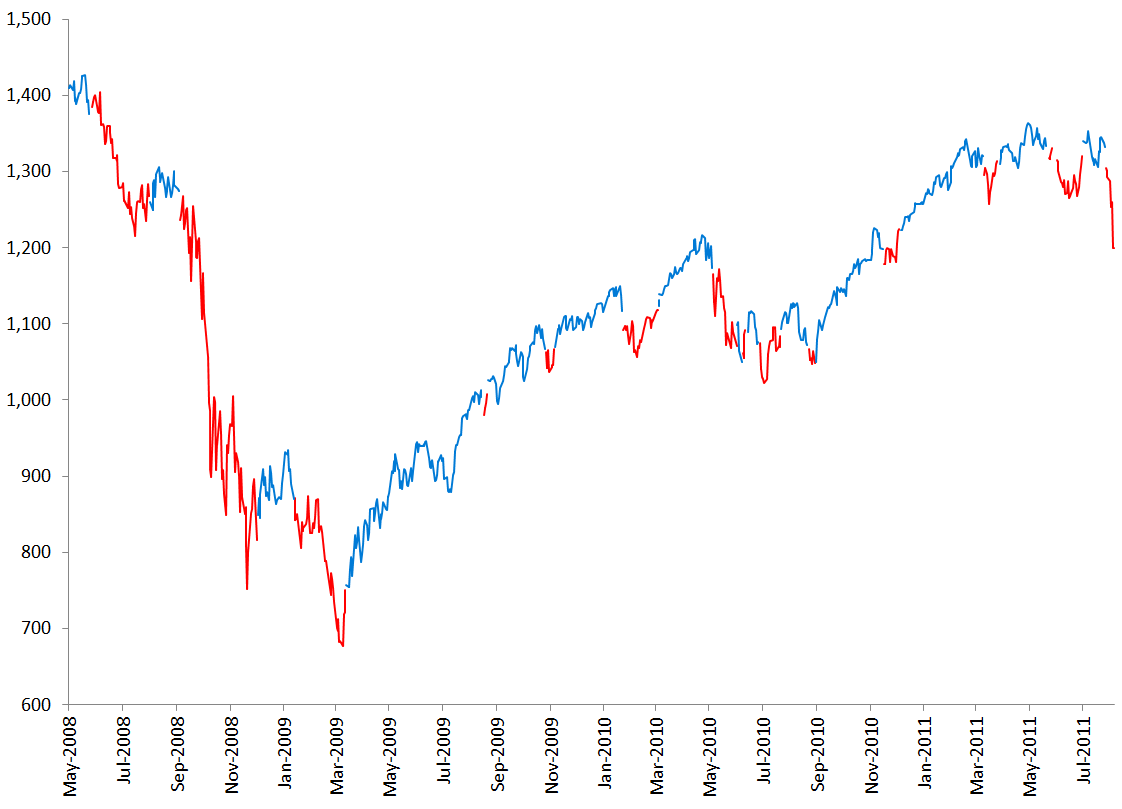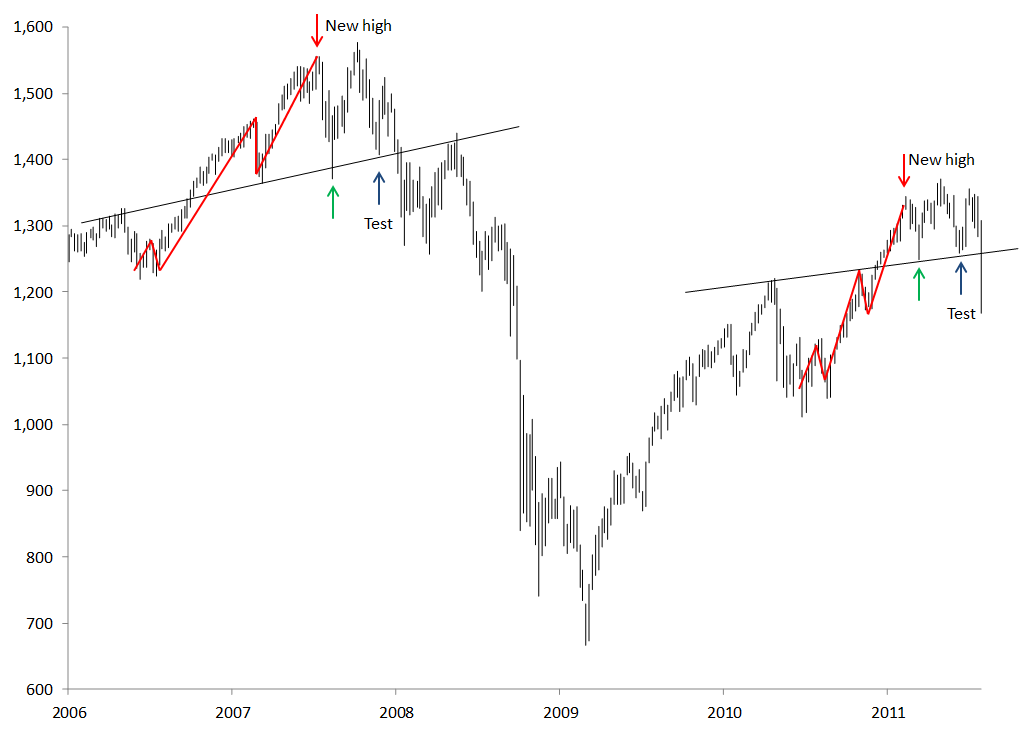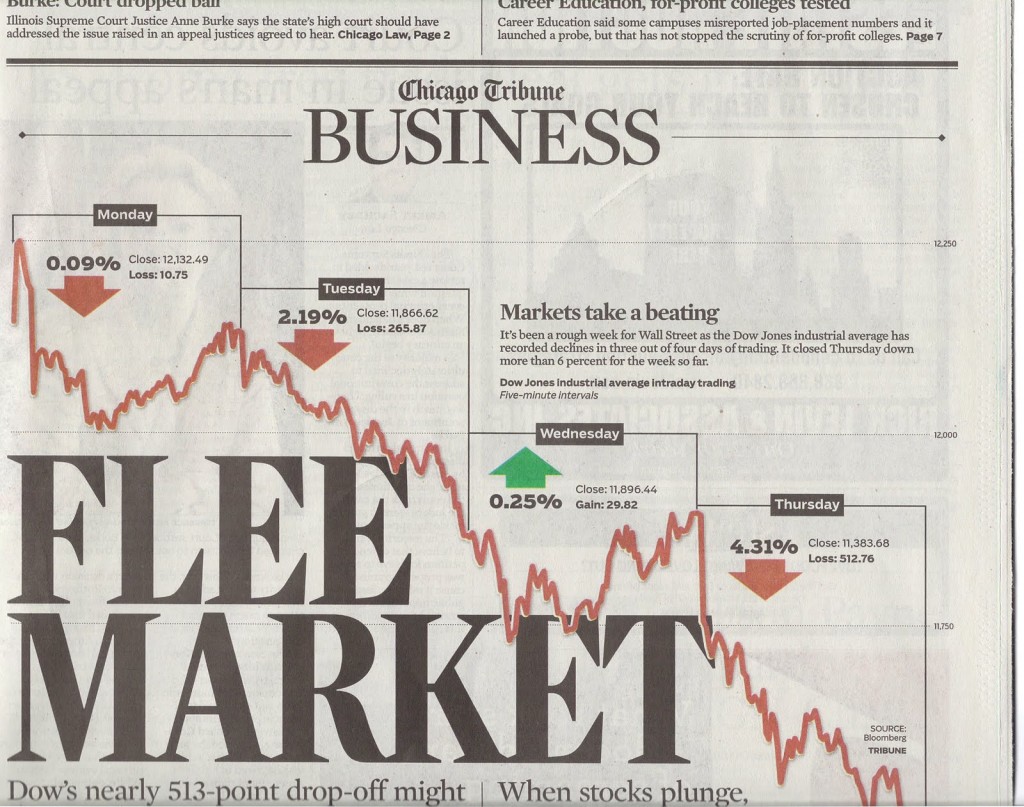Newsletter #2, 2011: Last week was brutal, but what can we expect going forward?
2 CommentsSunday • August 7, 2011 • by ewmoe
The S&P 500 was down 7.2 % last week, which was the largest selloff in 32 months! This selloff has in a little over a week wiped out USD 2.0 trillion, almost the same amount as the combined size of QE1 and QE 2. This just shows how fast asset values can deteriorate in a stock market downtrend. In other words this was a big event.
I have not sent out a newsletter for many months now, the last one was on March 25th, but I feel that the performance of the market over the last few weeks calls for another one now. Before I get into what I will discuss today I want to remind you to pay close attention to the model I use to calculate the turning points in the market. The model does not perform that well in a choppy market like we have had for most of this year, but in a longer time frame, as the chart below indicates, it has performed pretty OK.
Performance of the model since its inception in May 2008. The line is BLUE those days that the model indicates that we are in an UPTREND and RED those days that it indicates that we are in a DOWNTREND.
I am covering the following topics in today’s newsletter:
- The implications of the US credit downgrade and why the US should attack Switzerland
- Still no sign of leadership from Washington
- Official numbers say that unemployment is falling, but does that really matter?
- Is this market correction the start of another bear market?
The implications of the US credit downgrade and why the US should attack Switzerland
The S&P downgraded the credit rating of the USA from AAA to AA+ after the close Friday. This is the first time in history that US credit rating has been downgraded from the top spot. The different rating agencies have been warning about a potential downgrade for a long time so it shouldn’t have come as too big of a shock on the markets, but still, it is a big event. And seeing it in perspective of the market action over the last week it could almost seem like someone knew that the downgrade was coming this Friday. Wonder if someone knew?
But why would anyone listen to the rating agencies anyway? They were miserably behind the curve during the subprime crisis, and they were, in fact, a large part of the reason why the asset bubble was allowed to develop as far as it did in the first place. Not sure what they have done since then to have improved their credibility much. And even if they have, their history of being behind the curve is much longer. But despite their bad track record, this downgrade will probably add more uncertainty to the market over the coming weeks.
Buffett, who is a majority shareholder in S&P’s competitor, Moody’s, argued on Bloomberg Television on Saturday that he thinks the US merits a triple A rating as he don’t think we are facing a double dip recession.
Many agree with Mr. Buffett that it was erroneous to downgrade the US. The most horrendous utterance of personal opinion in that regard I found over the weekend came from an otherwise pretty insightful person. He argued that the creditworthiness of the US had nothing to do about debts, economic policy, entitlements, tax revenues or budget deficits, but rather that the key component was military might and that the US could invade, for instance, Switzerland any time they wanted, steal all their gold and in that way pay down all their debts. Creative I must say, but seriously, pretty scary that people who run a well-established and respected financial newsletter can publish something like this. I also mention because I think we will continue to see much stronger language and even crazier ideas becoming more and more mainstream in the years to come. Hope public opinion won’t be tempted to solve the financial problems through military conflict once the next crisis hits us.
I obviously disagree with the latter person, but I also disagree with Mr. Buffett, on both accounts actually; I think that the US should have been downgraded a long time ago and I also think we are heading towards a double dip recession. Well actually, I don’t think we are heading towards a recession, but rather the greatest economic depression that the world has ever seen in peacetime. I will argue my opinions in a later update (or you can take a look at some of my previous newsletters by clicking here).
Many people argue that the US can’t default because they can just print themselves out of trouble, and if you are one of those who share that argument, I suggest you study what happened in the Weimar Republic who also had a printing press addiction in lack of alternatives to finance their budget deficits. The conclusion to the story was that it was not a very successful venture; and the only guy who came out on top was named Adolf. Whatever the technical term one chooses to use, the US is heading towards a big financial crisis and it is likely to end in bankruptcy. The politicians have proven over and over again that there is no political will to make the necessary changes to secure an economic sustainable future.
Still no sign of leadership from Washington
The political process around the way the last increase in the debt ceiling was handled speaks for itself. There is only a miniscule probability that a country with politicians who go about to solve critical long-term issues in the way they have done over the past few weeks will ever be able to constructively work itself out of the immense problems they are facing. Let’s put the achievements, which Obama apparently was very happy and proud about, in perspective:
Before the agreement, the current USD 14 trillion national debts were on track to become a USD 24 trillion national debt by 2021. After the agreement, the official 2021 estimate is USD 21 trillion. When did that ever become an achievement? We went from extremely bad to not that extremely bad. We are not reducing the overall debt at all; we are only growing it at a lower rate – 4.1% instead of 5.5% annually over the next 10 years. Most people agree that Greece has a lot of debt at around 150% of GDP, but in the pace we are growing our debt we will be at the same level in 10 years; that is if you believe in the official forecasts. I obviously think the US will reach this level much earlier, mainly due to a contraction in GDP. But contraction in GDP or not, if the US government was following US GAAP, which it forces all listed companies to follow, it would be a lot worse. US GDP currently stands around USD 14.7 trillion.
- Official national debt is USD 14.3 trillion – all is on the “balance sheet” of the government. This level makes the debt to GDP ratio come to right above 100% and on par with Italy which is about to meet serious problems any moment soon.
- In addition the US government has USD 5 trillion of debt related to Fannie Mae and Freddie Mac. This is not on the “balance sheet,” so not part of the official number.
- USD 62 trillion: Total liabilities and unfunded obligations for Social Security and Medicare; neither on the “balance sheet.”
That is a total of more than USD 81 trillion, or a debt to GDP of 550%. And this number does not even include all obligations the US government has. According to Laurence J. Kotlikoff, who served as a senior economist on President Ronald Reagan’s Council of Economic Advisers and is a professor of economics at Boston University, “if you add up all the promises that have been made for spending obligations, including defense expenditures, and you subtract all the taxes that we expect to collect, the difference is USD 202 trillion.” That is a debt to GDP ratio of close to 1400%! “To get our overall fiscal gap under control he continues in a Bloomberg editorial, “the U.S. must cut spending or raise tax revenue by $20 trillion over the next decade, far more than either the president wants or the House Republicans seek.” Putin had a nice way of saying it the other day “It (the US) is not living within its means, shifting the weight of responsibility on other countries and in a way acting as a parasite.” Parasite or not, the US is surely the most indebted nation in the history of the human race.
As you all understand, no matter what the real number is, it is still so high that the future will not be as we currently expect. Drastic measures must be taken, but there is no one willing to stick out their head, so don’t expect that to happen anytime soon. I think we will have to go through a severe depression before there is enough willingness to make the tough decisions that needs to be made to correct our current unsustainable financial system. Which is also another reason why I think a depression is unavoidable.
Official numbers say that unemployment is falling, but does that really matter?
Then the good news: Unemployment fell 0.1%-point to 9.1% last month. If we however look at the labor force participation rate (the number of adults who participate in the workforce), the picture does not look that good. It fell as well, which is not a good thing, to 63.9%. This is the lowest reading since January 1984! This is a symptom of an aging population, which we have in the US (baby boomers approaching retirement age). This measure is going to continue to fall going forward; that means less money for consumers, less earnings for companies, less tax income and increased costs for the government. Another argument for why we are approaching a depression.
Is this market correction the start of another bear market?
Back to the big fall in the stock market. The question on everyone’s lips right now: Is this the start of the second leg down in a double dip recession or not? For the moment pretty much all technical indicators are extremely oversold. When they are at such levels stocks either tend to put in a major bottom, followed by an uptrend that lasts several months, or they make a sharp V, retracing a fairly large part of the decline before they continue to fall. There are all kind of different arguments supporting both scenarios, and many others, and it is pretty hard to get a good grip of any of them.
I made the chart below based on an analysis I found in an Elliott Wave article. Not that just because you have seen a pattern before I needs to repeat itself. Most often it does not. But what you at least should do, which will not take too much effort on your side, is to see how the S&P will react when it approaches horizontal line from the downside. Will it break decisively through it or will it meet resistance and break down again like it did half-way through 2008. If it meets resistance it increases the likelihood that we will see another major crash in the indexes just like we did in 2008. Keep an eye on that line!
S&P 500 weekly high-low bars
If you bring up another chart of the S&P 500 with a 200 DMA (day moving average) line on it, there is one thing that you should pay attention to that has not yet turned to support a negative stance. The 200 DMA is still rising and will continue to do so unless the index drops another 2%. According to Carl Futia, in a bull market, which we have been in since March 2009, a drop below the 200 DMA is a buying opportunity. A falling 200 DMA is for some technicians a sign of a confirmed bear market. Be on extra alert if the S&P falls 2% or more from current levels!
One could also argue that the reason why we have seen the last three year bull market is due to quantitative easing (QE). At the end of QE1 last spring, the S&P fell 13%, and since the end of QE2 in June this year the S&P is down 9%. Should we expect QE3 to be just around the corner? The Fed will issue a statement on Tuesday so there might be some hints of it already then. Not that Q3 is going to make the slightest amount of difference to anything that matters like output, demand or employment, but so far the stock market has liked it and I would not be shocked if it would continue to enjoy another round of “funny money.” Pay attention to what the Fed is saying tomorrow!
One last thing, Mr. Futia, also posted this picture on his blog. When the headlines in the most popular newspapers tell you to “flee the market” it is based on history a very good time to do the exact opposite and enter it big time!
First page of business section Friday August 5th
Nobody knows for certain what the future will bring and that is why I have developed a model to help me maneuver in the stock market jungle. The best tip I can give you is to use the model as a supplementary tool when you trade the stock markets. The model is still in a downtrend and I don’t expect another uptrend to start without the model also indicating that one has started.
There is one thing I feel pretty certain about going forward – volatility will continue to stay high for a while and we are likely to see a lot of declines and sharp rebounds.
Hope this will help you guide the financial markets with more clarity. Comments and questions are as always more than welcome.
Best wishes for an interesting week in the markets!
Posted in: Financial
Tagged with: Carl Futia, crash, credit rating, debt ceiling, forecast, GDP, greece, italy, Laurence Kotlikoff, national debt, stock market, technical analysis, unemployment, US downgrade, Warren Buffett
About ewmoe:
2 Responses to “Newsletter #2, 2011: Last week was brutal, but what can we expect going forward?”
-
Pingback: Market in DOWNTREND – November 21st – Eirik W. Moe[...] presented the chart below the first time in the August 7th, 2011 Newsletter. And so far the similarity o... ewmoe.com/2011/11/21/market-in-downtrend-november-21st
-
[...] Below is an updated version of the chart that I posted in the newsletter from August 7th. [...]... ewmoe.com/2011/09/04/market-in-downtrend-september-4th
Archives
- December 2021 (1)
- August 2020 (1)
- March 2020 (2)
- October 2018 (1)
- March 2018 (3)
- February 2018 (1)
- July 2016 (1)
- June 2016 (2)
- January 2016 (1)
- December 2015 (2)
- September 2015 (1)
- August 2015 (1)
- February 2015 (1)
- December 2014 (1)
- November 2014 (1)
- October 2014 (1)
- August 2014 (2)
- May 2014 (1)
- March 2014 (1)
- February 2014 (1)
- January 2014 (1)
- October 2013 (2)
- September 2013 (1)
- August 2013 (1)
- July 2013 (1)
- June 2013 (3)
- April 2013 (2)
- March 2013 (1)
- February 2013 (1)
- December 2012 (1)
- October 2012 (1)
- July 2012 (1)
- June 2012 (2)
- May 2012 (1)
- April 2012 (2)
- December 2011 (1)
- November 2011 (1)
- October 2011 (1)
- September 2011 (1)
- August 2011 (2)
- July 2011 (2)
- June 2011 (4)
- May 2011 (1)
- March 2011 (3)
- December 2010 (1)
- November 2010 (1)
- September 2010 (1)
- August 2010 (1)



